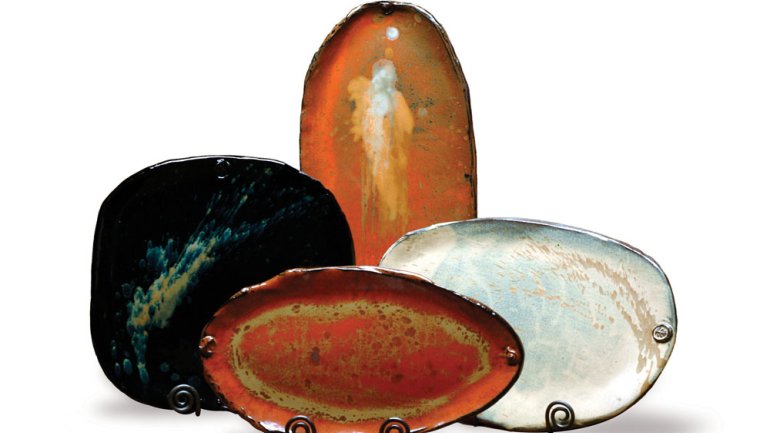Plate and Palate
Plate and Palate
We eat first with our eyes, they say, and if you’ve watched a TV cooking competition or dined out lately, you know it’s true. Whether the dish is a pristine arrangement accented with drizzle, foam, and zest or hearty fare served up in an artfully sloppy, just-fell-off-the-farm-truck heap, food has never been more visual.
As part of this emphasis on presentation, some chefs are looking beyond the traditional round white plate. “Right place, right time, right product” is how Tena Payne happily characterizes the success of her Earthborn Pottery, which supplies custom handmade pieces to high-end restaurants and hotels. Working out of a former wristwatch factory in Leeds, Alabama, just outside Birmingham, Payne’s team of seven (including her husband and son) turns out sturdy yet elegant wares in nature-inspired shapes and shades, from sky blues and pine-tree greens to the cream of cotton fields and the red of Alabama clay soil.
“My standard – what I love to make, kind of the Earthborn look – is very organic,” Payne says. “It’s thicker than your normal tableware. It looks like a rock that’s been dug up and polished. That’s what I’m going for – something that’s timeless, that speaks to the clay, that you can look at and know, ‘Gosh, that came out of the ground.’ ”
Payne’s customers include Chris Hastings, winner of the James Beard Foundation’s 2012 Best Chef in the South award, who has featured her plates and serving pieces for 15 years at his Birmingham restaurant, the Hot and Hot Fish Club; he also used them when he challenged (and beat) celebrity chef Bobby Flay on the Food Network’s Iron Chef America. Other high-profile Earthborn clients include the Bellagio and Mandarin Oriental hotels in Las Vegas; Sushisamba restaurants in Miami, New York, and London; and Ozumo restaurant in San Francisco.
Visiting these places on business, Payne gets to experience the thrill of eating exquisite food off her own plates. “Oh, it’s amazing, so cool,” she says. “It’s probably the biggest rush you can get. Especially out in Vegas. You know, I’m just a girl from Alabama.”
Self-taught, Payne started making ceramics as a high school student in the 1970s, and all her adult life dreamed of earning a living at it. For years she threw pots in her basement while working various day jobs (personnel consultant, corporate recruiter, editorial staffer, radio ad copywriter) and raising a family. One fateful day in 1997, she knocked on Hastings’ kitchen door, hoping to sell him some shiitake mushrooms she had farmed. The two got talking, and he wound up placing an order for some plates.
“Bless his sweet heart, he said, ‘You do whatever you want to do. I need it to do this,’ ” Payne recalls. “And then he gave me the criteria. He let me experiment.” With Hastings’ feedback, she refined and perfected her designs, testing different clays and glazes until she hit on a blend that proved durable enough to stand up to commercial use without chipping or cracking. By 2003 she “knew this could be something” and decided to go after the food-and-beverage market in earnest.
Some chefs, she found, resisted handmade wares, preferring factory products. “It was hard ground to break. A lot of chefs are real finicky and only want white plates, because they’re concerned about how the food looks, how their sauces show up. But most who use the colors have found that they really do pop the food, not fight it,” Payne says. “Once we got the product in service, the chefs started raving over it.”
Typically she’ll work with an executive chef, and sometimes an interior designer, to complement the overall concept of the restaurant as well as the cuisine. “The volume and portion sizes have to be consistent,” she says. “Everything else is up for expression.” Earthborn designs are also available to the public at the studio showroom, online, and at various retailers.
For Hastings, collaborating with Earthborn is part of the artisanal flavor he brings to every aspect of his restaurant, from its chairs, chandeliers, and curtain rods by local blacksmiths to a hutch and harvest table made of old wood from an Alabama mill. “It expresses the idea of place – not just the food of the season, but the craftsmanship of the community,” he says, adding that he considers himself a craftsman, feels a natural kinship with people who work materials creatively
with their hands.
Payne concurs. “Chefs know – the same way potters know – that they’re meant to do what they do,” she says.
“We both take our ingredients out of the ground. We rearrange them. We put them in the ovens or kilns. Then we put them out there for someone else to enjoy.”
Joyce Lovelace is American Craft’s contributing editor.

